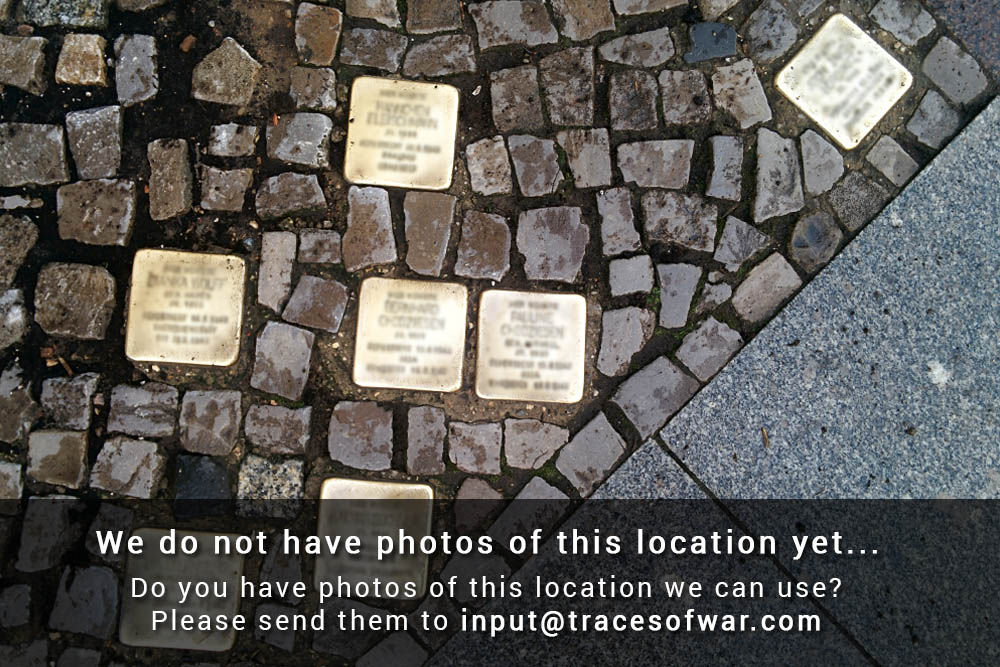Stumbling Stone Florastraße 84
This small, brass, memorial plaque (Stolperstein or stumbling stone) commemorates:
* Regina Spanier née Herrmann, born 1868, deported 1942, murdered 1943 in Riga.
Regina Herrmann and Julius Wilhelm Spanier, a merchant, married and moved to Herford. They had four children -- two sons (Arthur and Willy) who served in World War I and two daughters (Erna and Gertrud). In 1924, Regina, Julius, Arthur, and Gertrud all moved to Gelsenkirchen. Later, Gertrud married Simon Reifeisen and moved to Dorsten with him. Julius Spanier died in 1935. In 1938, the Reifeisens were part of the Polenaktion, which deported "back" to Poland any German with any Polish background. When they were allowed to return to Germany to settle their affairs, they went to stay with Regina Spanier on the ground floor of the building at Florastraße 84. Ruth Nussbaum and 3 children moved in with the Spaniers.
Simon Reifeison was in Gelsenkirchen prison; his 13-year-old daughter Ilse visited him in December 1939. Then that same month she was sent to Sweden on a kindertransport. The Spaniers wrote to Ilse regularly from then until their deportation in January 1942; most of these letters have been preserved.
Regina Spanier was deported with Gertrud and Gertrud’s husband Simon Reifeisen to Riga. Regina was killed when the Riga ghetto was liquidated in 1943. Her children Gertrud, Arthur, and Erna and their spouses also did not survive the Holocaust.
Stolpersteine for Gertrud Anna Reifeisen and Simon Reifeisen can be seen in Dorsten at Essener Straße 12.
Another stolperstein for Regina Spanier is in Herford, at Gehrenberg 17.
"Stolpersteine" is an art project for Europe by Gunter Demnig to commemorate victims of National Socialism (Nazism). Stolpersteine (stumbling stones) are small, 10x10cm brass plaques placed in the pavement in front of the last voluntary residence of (mostly Jewish) victims who were murdered by the Nazis. Each plaque is engraved with the victim’s name, date of birth, and place (mostly a concentration camp) and date of death. By doing this, Gunter Demnig gives an individual memorial to each victim. One stone, one name, one person. He cites the Talmud: "A human being is forgotten only when his or her name is forgotten."
Do you have more information about this location? Inform us!
Source
- Text: Fedor de Vries & Anne Palmer
- Photos: TracesOfWar.com
- Gelsenzentrum: De Familie Reifeisen
- Stolpersteine Gelsenfirchen: Regina Spanier
- Stolpersteine.eu
Nearby
Museum
Point of interest
- Air-Raid Shelter Günnigfelder Straße - Bochum
- Air Raid Shelter Gertrudisplatz - Bochum-Wattenscheid
- Air Raid Shelter Marienstraße - Bochum-Wattenscheid
Monument
- Memorial Crew Lancaster III LM327 - Gelsenkirchen
- Memorial Eastern European workers - Gelsenkirchen
- Mahnmal im Stadtgarten Gelsenkirchen - Gelsenkirchen
Cemetery
- German War Graves Günnigfeld - Günnigfeld
- German War Graves Wanne-Eickel - Wanne-Eickel
- German War Graves Hordel - Hordel



